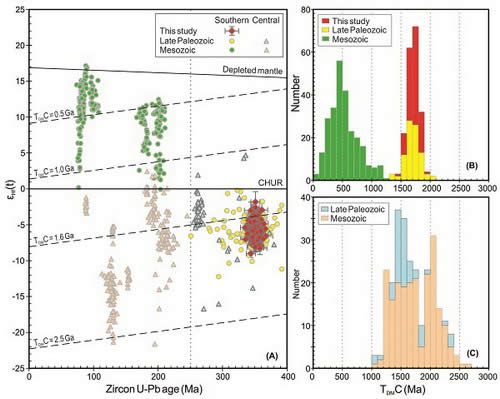Dentification of early Carboniferous granitoids from southern Tibet and implications for terrane assembly related to Paleo-Tethyan evolutionUpdate time:09 26, 2012
Postdocter JI Weiqiang and his teacher WU Fuyuan present zircon U-Pb and Hf isotope data, together with the whole-rock major- and trace-element composition, of Early Carboniferous granitoids newly identified from the Jiacha and Langxian areas in the southern Lhasa terrane, southern Tibet. Their data suggest that these granitoids were generated largely by reworking of Paleoproterozoic basement materials. In conjunction with literature data, it is further argued that the southern and central parts of the Lhasa terrane, separated by the Sumdo eclogite belt, should have been an integrated block before the late Paleozoic. Their study supports the notion that the Lhasa terrane was derived from the northern margin of Gondwanaland, in association with formation of at least two stages of Tethyan Ocean basins, now exposed as the Sumdo belt and the Indus-Tsangpo suture.
Fig. 1 A) U-Pb age versusεHf(t) value for late Paleozoic–Mesozoic zircons from Lhasa-Linzhi region. B) Crustal model age of late Paleozoic and Mesozoic zircons from the southern Lhasa terrane. C) Crustal model age of late Paleozoic and Mesozoic zircons from the central Lhasa terrane. Ji et al. Identification of early Carboniferous granitoids from southern Tibet and implications for terrane assembly related to Paleo-Tethyan evolution. The Journal of Geology. 2012, 120(5): 531-541(Download Here)
|
Contact
Related Articles
Reference
|
-
SIMSSecondary Ion Mass Spectrometer Laboratory
-
MC-ICPMSMultiple-collector ICPMS Laboratory
-
EM & TEMElectron Microprobe and Transmission Electron Microscope Laboratory
-
SISolid Isotope Laboratory
-
StIStable Isotope Laboratory
-
RMPARock-Mineral Preparation and Analysis
-
AAH40Ar/39Ar & (U-Th)/He Laboratory
-
EMLElectron Microscopy Laboratory
-
USCLUranium Series Chronology Laboratory
-
SASeismic Array Laboratory
-
SEELaboratory of Space Environment Exploration Laboratory
-
PGPaleomagnetism and Geochronology Laboratory
-
BioMNSFrance-China Bio-mineralization and Nano-structure Laboratory

 Print
Print Close
Close
